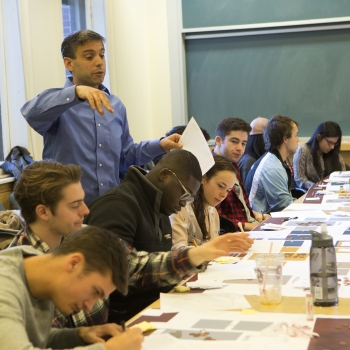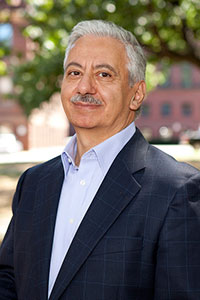News
Vikram Mansharamani, Lecturer on Engineering Sciences, advises students as they work through a hands-on manufacturing lesson in the new SEAS course Humanity and Its Challenges: Systems Thinking and Engineering Design Solutions (ES 26). (Photo by Adam Zewe/SEAS Communications.)
Students reach for shiny pennies sitting in piles on the table, counting and sliding coins back and forth.
The coins represent manufactured products worth millions of dollars in a hands-on lesson about a systems approach to manufacturing in the new Harvard John A. Paulson School of Engineering and Applied Sciences (SEAS) course Humanity and Its Challenges: Systems Thinking and Engineering Design Solutions (ES 26).
The course, co-taught by Fawwaz Habbal, Executive Dean for Education and Research, Cherry Murray, Benjamin Peirce Professor of Technology and Public Policy, and Vikram Mansharamani, Lecturer on Engineering Sciences, is designed to give students an appreciation of the complexities involved in some of the world’s most intractable problems and how a systems thinking approach is critical for developing effective solutions.
In the classroom example, students formed groups with each acting as a different link in a beer company’s production chain—factory, wholesale company, distributor, and retailer. The students saw how small fluctuations in customer demand put pressure on the system, and how knee-jerk production and distribution choices led to a glut of wasted inventory or a severe product shortage.
When the instructors doubled the flow of customer orders, every team fell into an out-of-control spiral of overproduction.
“It was interesting to see how the time lag involved in the manufacturing and distribution process created a flaw in our perceptions,” said Jordan Berman, A.B. ’17, a math concentrator. “The fallacies of human perception caused us to be unresponsive to trends.”
Fawwaz Habbal, Executive Dean for Education and Resaerch, pauses to give some feedback as he co-teaches a lesson on systems thinking. (Photo by Adam Zewe/SEAS Communications.)
The penny-based manufacturing example may have been simple, but that same concept can be applied to all sorts of complex problem where decision-makers struggle to envision the cascading effects of their actions, said Mansharamani.
“The point here is to show how keeping a local perspective has limitations,” he said. “The student’s misperceptions actually got worse over time. We want them to see how applying a systems dynamics lens can be used to attack the world’s most complex problems.”
Students will spend the term applying systems thinking to four global challenges: food systems, pandemics, inequality, and climate change. Each of these problems involves many interconnected systems, like the cause-and-effect pressures of feedback loops, and the implications of balancing and enhancing measures, such as regulations, Habbal explained.
For instance, solving income inequality seems like a noble goal, but policymakers may overcome the economic issues in ways that create unanticipated negative social, health, or environmental consequences.
“My hope is that students understand that as citizens of the world, as leaders, they should be very alert to not be quickly seduced by a one-dimensional solution, but think about the consequences of those solutions,” Habbal said. “I want them to see the role of humans in these systems, and how a system that is really simple becomes very complicated when people don’t agree.”
Students (from left) Oliver Falvey, A.B. '17, an economics concentrator, Patrick Siaw-Asamoah, A.B. '17, a psychology concentrator, and Elianna Shwayder, A.B. '18, a human evolutionary biology concentrator, collaborate during a manufacturing/distribution lesson in ES 26 that is designed to illustrate systems thinking. (Photo by Adam Zewe/SEAS Communications.)
The new course appeals to students of all backgrounds—only one third of those enrolled are SEAS concentrators. And while it is an engineering course, it is designed with a more humanistic than mathematical approach to problem solving, Habbal said. The goal is for all students, regardless of future career aspirations, to apply these systems thinking lessons broadly.
Elianna Shwayder, A.B. ’18, a human evolutionary biology concentrator, decided to enroll in ES 26 to develop a more interdisciplinary mindset. The most poignant lesson she has learned so far is that our ability to distinguish between simple, complicated, complex, and chaotic systems ultimately depends on the deepness of our knowledge about the systems' components.
“As an aspiring physician, I have learned the importance of evolutionary context in examining any illness or manifestation of disease,” she said. “I believe it will be my obligation to learn how to heal from a systems perspective.”
The broad applications of the course material, which touches on health care, science, business, and technology, could become a strong foundation for a potential secondary concentration in systems thinking, Habbal said. While ES 26 is still in its pilot stages, he sees it as the catalyst for a host of new courses designed to help Harvard students become the leaders the world needs.
Cutting-edge science delivered direct to your inbox.
Join the Harvard SEAS mailing list.
Scientist Profiles
Fawwaz Habbal
Senior Lecturer on Applied Physics
Press Contact
Adam Zewe | 617-496-5878 | azewe@seas.harvard.edu

